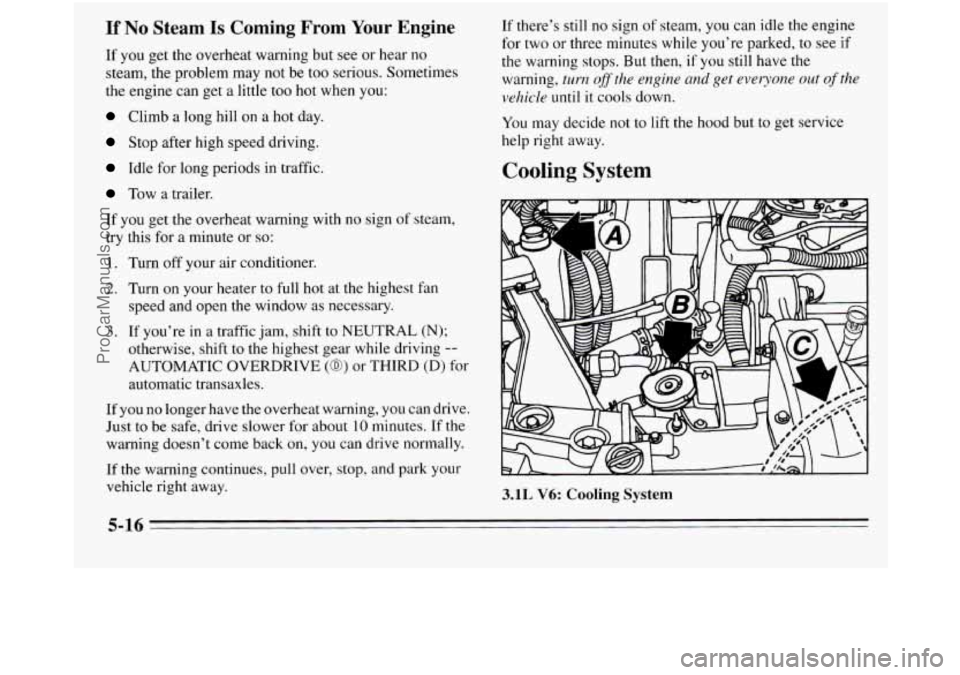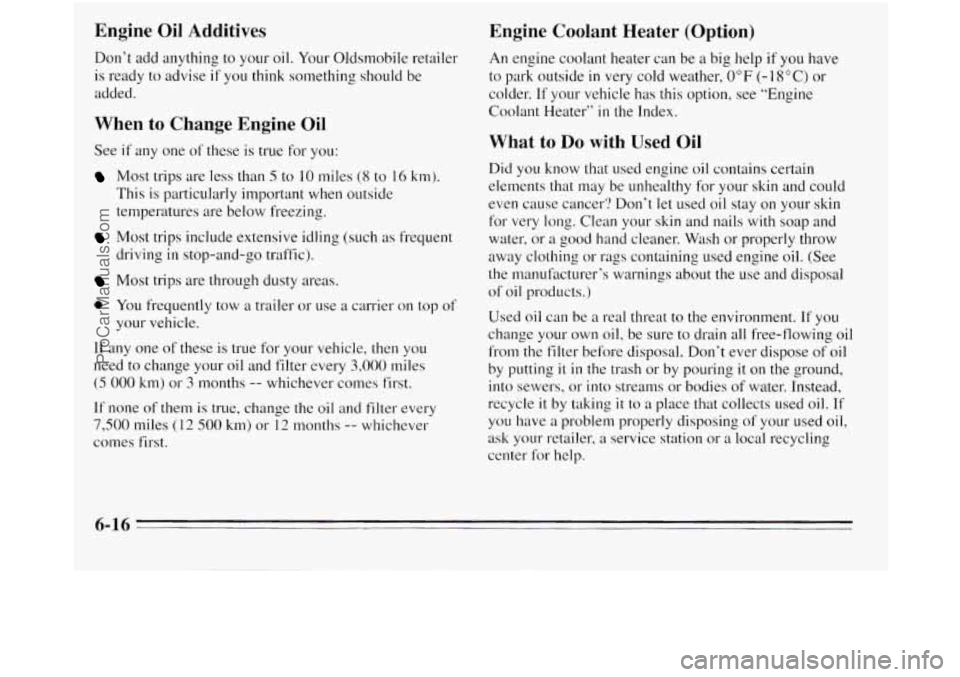Page 207 of 390

Include an ice scraper, a small brush or broom, a supply
of windshield washer fluid, a rag, some winter outer
clothing, a small shovel,
a flashlight, a red cloth, and a
couple of reflective warning triangles. And, if you will
be driving under severe conditions, include a small bag
of sand, a piece
of old carpet or a couple of burlap bags
to help provide traction. Be sure you properly secure
these items in your vehicle.
Driving on Snow or Ice
Most of the time, those places where your tires meet the
road probably have good traction.
However,
if there is snow or ice between your tires and
the road, you can have
a very slippery situation. You’ll
have a lot less traction or “grip” and will need to be very
careful.
What’s the worst time for this? “Wet ice.” Very cold
snow or ice can be slick and hard to drive on. But wet
ice can be even more trouble because it may offer the
least traction of all. You can get “wet ice” when it’s
about freezing
(32 OF; 0” C) and freezing rain begins to
fall. Try
to avoid driving on wet ice until salt and sand
crews can get there.
4-25
ProCarManuals.com
Page 223 of 390
w
Section 5 Problems on the Road
Here you’ll find what to do about some problems that
can occur
on the road.
Hazard Warning Flashers
Your hazard warning flashers let you warn others.
They
also let police know you have a problem. Your
front and rear turn signal lamps will flash on
and off.
Your hazard warning flashers switch
is on the steering
column, below the ignition switch.
Press the button in to
turn
on your flashers.
5-1
ProCarManuals.com
Page 224 of 390
Your hazard warning flashers work no matter what
position your key is in, and even if the key isn’t in.
To turn off the flashers, pull out on the collar.
When the hazard warning flashers are on, your turn
signals won’t work.
Other Warning Devices
If you carry reflective triangles, you can set one up at the
side of
the road about 300 feet (100 m) behind your vehicle.
Jump Starting
If your battery has run down, you may want to use
another vehicle and some jumper cables to start your
Oldsmobile. But please follow the steps below to do it
safely.
On vehicles equipped with the optional power sliding
door, a low voltage battery or replacing a battery may
cause the system to become inoperative. Refer to “Power
Sliding Door” in the Index for more information.
5-2
ProCarManuals.com
Page 230 of 390
Towing Your Vehicle
J
I
Try to have a GM dealer or a professional towing
service tow your vehicle. The usual towing
equipment
is:
(A) Sling-type tow truck
(B) Wheel-lift tow truck
(C) Car carrier
If your vehicle has been changed or modified since it
was factory-new by adding aftermarket items like fog
lamps, aero skirting, or special tires and wheels, these
instructions and illustrations may not be correct.
Before you do anything, turn
on the hazard warning
flashers.
5-8
ProCarManuals.com
Page 238 of 390

If No Steam Is Coming From Your Engine
If you get the overheat warning but see or hear no
steam, the problem may not be too serious. Sometimes
the engine can get
a little too hot when you:
Climb a long hill on a hot day.
Stop after high speed driving.
Idle for long periods in traffic.
Tow a trailer.
If you get the overheat warning with no sign
of steam,
try this for a minute or
so:
1. Turn off your air conditioner.
2. Turn on your heater to full hot at the highest fan
speed and open the window as necessary.
3. If you’re in a traffic jam, shift to NEUTRAL (N);
otherwise, shift to the highest gear while driving --
AUTOMATIC OVERDRIVE (a) or THIRD (D) for
automatic transaxles.
If you no longer have the overheat warning, you can drive.
Just to be safe, drive slower for about
10 minutes. If the
warning doesn’t come back on, you can drive normally.
If the warning continues, pull over, stop, and park your
vehicle right away.
If there’s still no sign of steam, you can idle the engine
for two or three minutes while you’re parked, to see if
the warning stops. But then, if you still have the
warning,
turn off the engine and get everyone out of the
vehicle
until it cools down.
You may decide not to lift the hood but to get service
help right away.
Cooling System
3.1L V6: Cooling System
5-16
ProCarManuals.com
Page 241 of 390
How to Add Coolant to the Coolant
Recovery Tank
If you haven’t found a problem yet, but the coolant
level isn’t at or above the
FULL HOT mark, add a
50/50 mixture of clean water (preferably distilled) and
a proper antifreeze at the coolant recovery tank. (See
“Engine Coolant” in the Index for more information
about the proper coolant
mix.)
NOTICE:
In cold weather, water can freeze and crack the
engine, radiator, heater core and other parts. Use
the recommended coolant.
When the coolant in the coolant recovery tank is at or
above the
FULL HOT mark, start your vehicle.
If the overheat warning continues, there’s one more
thing you can try. You can add the proper coolant mix
directly to the radiator, but be sure the cooling system
is
cool before you do it.
5-19
ProCarManuals.com
Page 246 of 390

If a Tire Goes Flat
It’s unusual for a tire to “blow out” while you’re driving,
especially if
you maintain your tires properly. If air goes
out
of a tire, it’s much more likely to leak out slowly.
But if
you should ever have a “blowout,” here are a few
tips about what to expect and what to do:
If a front tire fails, the flat tire will create
a drag that
pulls the vehicle toward that side. Take your foot off the
accelerator pedal and grip the steering wheel firmly.
Steer to maintain lane position, then gently brake to
a
stop well out of the traffic lane.
A rear blowout, particularly on a curve, acts much like a
skid and may require the same correction you’d use in a
skid. In any rear blowout, remove your foot from the
accelerator pedal. Get the vehicle under control by
steering the way you want
the vehicle to go. It may be
very bumpy and noisy, but you can still steer. Gently
brake to a stop, well
off the road if possible.
If
a tire goes flat, the next part shows how to use your
jacking equipment
to change a flat tire safely.
Air Inflator (Option)
Your vehicle may have an air inflator for use in bringing
tires up to the proper pressure.
To learn about it, see
“Air Inflator System’’ in the Index.
Changing a Flat Tire
If a tire goes flat, avoid further tire and wheel damage
by driving slowly to
a level place. Turn on your hazard
warning flashers.
5-24
ProCarManuals.com
Page 276 of 390

Engine Oil Additives
Don’t add anything to your oil. Your Oldsmobile retailer
is ready
to advise if you think something should be
added.
When to Change Engine Oil
See if any one of these is true for you:
Most trips are less than 5 to 10 miles (8 to 16 krn).
This
is particularly important when outside
temperatures are below freezing.
Most trips include extensive idling (such as frequent
driving
in stop-and-go traffic).
Most trips are through dusty areas.
0 You frequently tow a trailer or use a carrier 011 top of
your vehicle.
If any one
of these is true for your vehicle, then you
need to change your oil and filter every
3,000 miles
(5 000 km) or 3 months -- whichever comes first.
If none
of them is true, change the oil and filter every
7,500 miles (12 500 km) or I2 months -- whichever
comes first.
Engine Coolant Heater (Option)
An engine coolant heater can be a big help if you have
to park outside
in very cold weather, 0°F (- 18OC) or
colder.
If your vehicle has this option, see “Engine
Coolant Heater”
in the Index.
What to Do with Used Oil
Did you know that used engine oil contains certain
elements that may
be unhealthy for your skin and could
even cause cancer? Don’t let used oil stay on your skin
for very long. Clean your skin and nails with soap and
water, or
a good hand cleaner. Wash or properly throw
away clothing or rags containing used engine oil. (See
the manufacturer’s warnings about the use and disposal
of oil products.)
Used oil can be
a real threat to the environment. If you
change your own oil, be sure
to drain all free-flowing oil
from the filter before disposal. Don’t ever dispose of oil
by putting it
in the trash or by pouring it on the ground,
into sewers, or into streams or bodies of water. Instead,
recycle
it by taking it to a place that collects used oil. If
you have a problem properly disposing of your used oil,
ask your retailer, a service station or a local recycling
center for help.
6-16
ProCarManuals.com